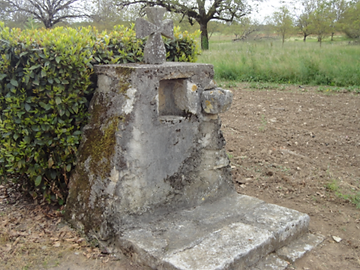Crosses
Punctuating the spaces of a crossroad, the roadside crosses are where reflective pauses and a sacred gathering of one's thoughts are necessary before a new direction is chosen. Situated throughout our countryside, they remind us at all times of the presence (and surveillance, as 'sanction' is never far away) of God. Passersby see the crosses as a signal that they approach somewhere, they are a worldly indicator. They are a commemoration of liturgical events, of the rhythm of community life, pastoral missions, jubilees and ritual episodes of plenary indulgences granted by the Pope during the Calendar Year of Saints.
The Materials used in construction
Christian crosses may be constructed in different materials, each with a significance and role. The five principal materials used are: stone, concrete, iron, wrought iron or wood.
Stone, - an excellent perennial material, it is used in making crosses of long duration. It represents the timelessness of faith and allows hieratic elements to complement the sense. Stone is a material used since ancient times and easily used. It needs no maintenance and is well known to artisans as a 'noble material'.
Concrete – is less durable due to the iron it often contains and oxidisation provokes shattering or splintering. It is characteristic of 20th Century crosses, 'modern' , easily used, more durable than wood but less 'noble' than other materials. Concrete crosses are often constructed on more ancient foundations.
Iron – is used for the creation or restoration of Calvary Crosses and above all was used at the beginning of the 19th Century. The metal enables a finer graduation in its execution, in that one can see profile to the corner irons or on the flat surfaces, with various sections made of curled scrolls resembling lace, all made in the forge. Wrought iron is also used and permits a series of crosses to be created at the same time, this work being undertaken by specialist companies.
Wood - is used in the creation of crosses strongly referring to the Calvary, Christ's Passion which itself was made of wood. However, exposed to the elements, the longevity of wooden crosses is limited without maintenance.
Travelling the small roads and pathways of Tourtoirac, one comes across half a dozen crosses. Here are the best known:

The cross of St. Trie .
This metal cross, 2.5 metres high standing on a stone pedestal, is a processional cross serving to mark the arrival or departure point of a Christian procession. St. Trie has also given its name to a commune a dozen kilometres from Tourtoirac, where one can find the vestiges of 12th century Dalon Abbey.

The cross of Portail.
A 20th century painted wooden cross, 1.7 metres high on a stone pedestal, it is in poor condition

The cross of Chambon.
Was offered to the commune in the 19th century. In limestone, 35 cm high on a carved stone plinth of 1.5 metre, there is a small niche designed to house a statuette.
The cross of Rozier.
Is a well maintained processional cross inwrought iron, 40 cm high on a pedestal of two blocks of limestone, a total height of 1.9metre.


